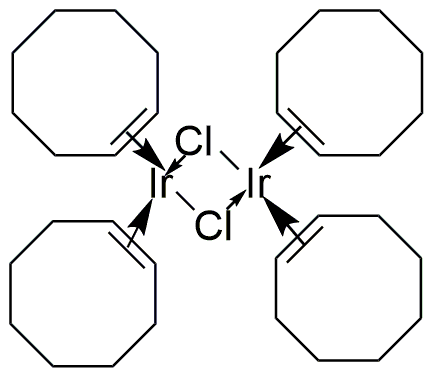Chlorobis(cyclooctene)iridium(I) Dimer is widely utilized in research focused on various applications:
- Catalysis: This compound serves as a catalyst in organic reactions, particularly in the synthesis of complex molecules, enhancing reaction rates and selectivity.
- Material Science: It is used in the development of advanced materials, including polymers and nanomaterials, due to its unique properties that facilitate the formation of novel structures.
- Pharmaceutical Development: Researchers leverage its catalytic properties in drug synthesis, streamlining the production of pharmaceutical compounds with improved efficacy.
- Environmental Chemistry: It plays a role in environmental applications, such as the degradation of pollutants, by acting as a catalyst in reactions that break down harmful substances.
- Photochemistry: The compound is utilized in photochemical studies, contributing to the understanding of light-induced reactions and the development of light-activated materials.
General Information
Properties
Safety and Regulations
Applications
Chlorobis(cyclooctene)iridium(I) Dimer is widely utilized in research focused on various applications:
- Catalysis: This compound serves as a catalyst in organic reactions, particularly in the synthesis of complex molecules, enhancing reaction rates and selectivity.
- Material Science: It is used in the development of advanced materials, including polymers and nanomaterials, due to its unique properties that facilitate the formation of novel structures.
- Pharmaceutical Development: Researchers leverage its catalytic properties in drug synthesis, streamlining the production of pharmaceutical compounds with improved efficacy.
- Environmental Chemistry: It plays a role in environmental applications, such as the degradation of pollutants, by acting as a catalyst in reactions that break down harmful substances.
- Photochemistry: The compound is utilized in photochemical studies, contributing to the understanding of light-induced reactions and the development of light-activated materials.
Documents
Safety Data Sheets (SDS)
The SDS provides comprehensive safety information on handling, storage, and disposal of the product.
Product Specification (PS)
The PS provides a comprehensive breakdown of the product’s properties, including chemical composition, physical state, purity, and storage requirements. It also details acceptable quality ranges and the product's intended applications.
Certificates of Analysis (COA)
Search for Certificates of Analysis (COA) by entering the products Lot Number. Lot and Batch Numbers can be found on a product’s label following the words ‘Lot’ or ‘Batch’.
*Catalog Number
*Lot Number
Certificates Of Origin (COO)
This COO confirms the country where the product was manufactured, and also details the materials and components used in it and whether it is derived from natural, synthetic, or other specific sources. This certificate may be required for customs, trade, and regulatory compliance.
*Catalog Number
*Lot Number
Safety Data Sheets (SDS)
The SDS provides comprehensive safety information on handling, storage, and disposal of the product.
DownloadProduct Specification (PS)
The PS provides a comprehensive breakdown of the product’s properties, including chemical composition, physical state, purity, and storage requirements. It also details acceptable quality ranges and the product's intended applications.
DownloadCertificates of Analysis (COA)
Search for Certificates of Analysis (COA) by entering the products Lot Number. Lot and Batch Numbers can be found on a product’s label following the words ‘Lot’ or ‘Batch’.
*Catalog Number
*Lot Number
Certificates Of Origin (COO)
This COO confirms the country where the product was manufactured, and also details the materials and components used in it and whether it is derived from natural, synthetic, or other specific sources. This certificate may be required for customs, trade, and regulatory compliance.


